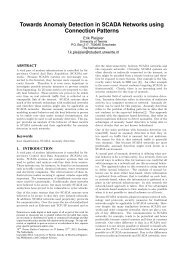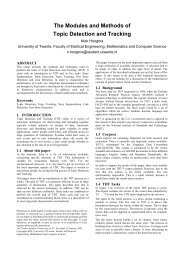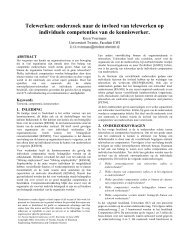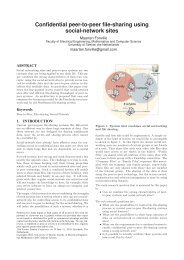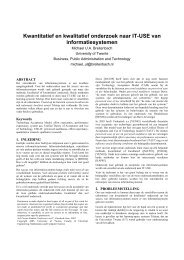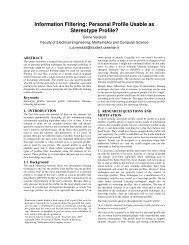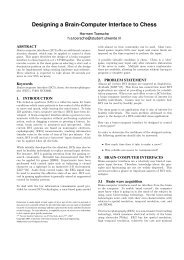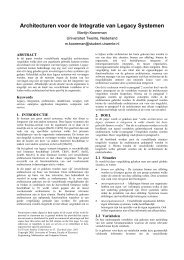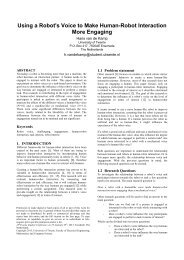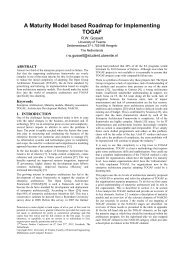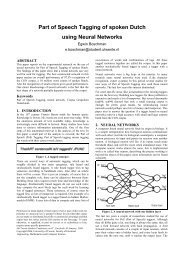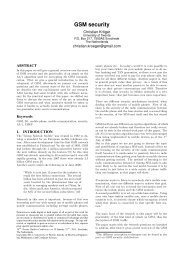SaaS Sales Compensation Models - Twente Student Conference on IT
SaaS Sales Compensation Models - Twente Student Conference on IT
SaaS Sales Compensation Models - Twente Student Conference on IT
You also want an ePaper? Increase the reach of your titles
YUMPU automatically turns print PDFs into web optimized ePapers that Google loves.
<str<strong>on</strong>g>SaaS</str<strong>on</strong>g> <str<strong>on</strong>g>Sales</str<strong>on</strong>g> <str<strong>on</strong>g>Compensati<strong>on</strong></str<strong>on</strong>g> <str<strong>on</strong>g>Models</str<strong>on</strong>g><br />
Boyan Lazarov<br />
University of <str<strong>on</strong>g>Twente</str<strong>on</strong>g><br />
P.O. Box 217, 7500AE Enschede<br />
The Netherlands<br />
b.g.lazarov@student.utwente.nl<br />
ABSTRACT<br />
This paper has the purpose of introducing and analyzing the<br />
emerging problem of compensating sales agents in companies<br />
entering <str<strong>on</strong>g>SaaS</str<strong>on</strong>g> markets. At first general management of sales<br />
force is overviewed, regarding sales roles, revenue and margin<br />
focus, strategies, and quotas. Sec<strong>on</strong>dly, a <str<strong>on</strong>g>SaaS</str<strong>on</strong>g> compensati<strong>on</strong><br />
model is given, placing the focus <strong>on</strong> recurring revenue. Next,<br />
both product and service orientated compensati<strong>on</strong> models are<br />
compared. The c<strong>on</strong>clusi<strong>on</strong> is that the difference between both<br />
compensati<strong>on</strong> models is not the expected drop of commissi<strong>on</strong><br />
rate but it is the lack of clarity in the payment scheme of the<br />
sales agents.<br />
Keywords<br />
Cloud computing, <str<strong>on</strong>g>SaaS</str<strong>on</strong>g>, sales compensati<strong>on</strong> models, service<br />
and product based software companies, incentive cost<br />
1. INTRODUCTION<br />
Nowadays, marketing strategies are more important for<br />
software companies than ever before. The traditi<strong>on</strong>al enterprise<br />
sales model is broken. Selling software, both through upfr<strong>on</strong>t<br />
fees or l<strong>on</strong>g-term licenses, is “struggling” and “panting”<br />
because customers’ and big businesses’ demands are changing.<br />
Therefore, a different approach is needed and many software<br />
companies have already followed the new trend in the<br />
computing industry – Cloud computing.<br />
Cloud computing is a term which originates from the early days<br />
of the Internet. Basically, clouds were used as abstracti<strong>on</strong> for<br />
networks. Nowadays, by cloud computing is meant the<br />
delivering of computing as a service rather than a product [8].<br />
The cloud computing provides three general service models –<br />
Software as a Service (<str<strong>on</strong>g>SaaS</str<strong>on</strong>g>), Platform as a Service (PaaS) and<br />
Infrastructure as a Service (IaaS), and four deployment models<br />
– Private Cloud, Community Cloud, Public Cloud and Hybrid<br />
Cloud [9].<br />
The focus of this study – <str<strong>on</strong>g>SaaS</str<strong>on</strong>g>, is a web-based software<br />
available for clients via any up-to-date web browser. This<br />
allows the customers to use the rich features and functi<strong>on</strong>ality<br />
Permissi<strong>on</strong> to make digital or hard copies of all or part of this work for<br />
pers<strong>on</strong>al or classroom use is granted without fee provided that copies<br />
are not made or distributed for profit or commercial advantage and that<br />
copies bear this notice and the full citati<strong>on</strong> <strong>on</strong> the first page. To copy<br />
otherwise, or republish, to post <strong>on</strong> servers or to redistribute to lists,<br />
requires prior specific permissi<strong>on</strong> and/or a fee.<br />
16 th <str<strong>on</strong>g>Twente</str<strong>on</strong>g> <str<strong>on</strong>g>Student</str<strong>on</strong>g> <str<strong>on</strong>g>C<strong>on</strong>ference</str<strong>on</strong>g> <strong>on</strong> <strong>IT</strong>, January 27 th , 2012, Enschede,<br />
The Netherlands.<br />
Copyright 2012, University of <str<strong>on</strong>g>Twente</str<strong>on</strong>g>, Faculty of Electrical Engineering,<br />
Mathematics and Computer Science.<br />
of a desktop applicati<strong>on</strong> but via any computer with internet<br />
access. The services could vary from very simple applicati<strong>on</strong>s<br />
like e-mail clients to complicated and sophisticated programs<br />
for accounting, financial management, project management,<br />
c<strong>on</strong>tent management systems and others [16].<br />
The benefits that <str<strong>on</strong>g>SaaS</str<strong>on</strong>g> provides are many, such as [15]:<br />
<br />
<br />
<br />
<br />
Time saving because it is ready to run software and it<br />
does not require any installati<strong>on</strong>.<br />
Most of the cloud services are standardized assets<br />
that can be used for enterprise’s core operati<strong>on</strong>s or<br />
with other applicati<strong>on</strong>s.<br />
Low risk because <str<strong>on</strong>g>SaaS</str<strong>on</strong>g> uses pay-per-use business<br />
model and the risk of investing large amount of<br />
resources is eliminated.<br />
Flexibility – cloud vendors could satisfy specific<br />
customer demands by different set of functi<strong>on</strong>ality<br />
which could be further evolved and enhanced.<br />
Paper structure<br />
The main objectives and motivati<strong>on</strong> about this study are given,<br />
followed by the research questi<strong>on</strong>s. In the next fourth chapter<br />
the general management of sales force is discussed regarding<br />
both classical software and <str<strong>on</strong>g>SaaS</str<strong>on</strong>g> companies. In the fifth chapter<br />
the focus falls <strong>on</strong> <str<strong>on</strong>g>SaaS</str<strong>on</strong>g> sales compensati<strong>on</strong> models and after<br />
that, in the sixth chapter, it is made a comparis<strong>on</strong> between<br />
service-based and product-based compensati<strong>on</strong> models. At the<br />
end, a c<strong>on</strong>clusi<strong>on</strong> is drawn.<br />
2. OBJECTIVES AND MOTIVATION<br />
FOR STUDY<br />
The uncertainty of global markets and the shift from competitor<br />
orientated to customer orientated markets forces standard<br />
software companies to offer services, such as maintenance, to<br />
compensate the decreasing sales of products and customers’<br />
satisfacti<strong>on</strong>. However, it is estimated by Gartner that cloud<br />
services will grow twice the speed of traditi<strong>on</strong>al software in the<br />
future (fig.1), achieving five-year compound annual growth rate<br />
[7] (CAGR 1 ) of 16,3%, while for the latter CAGR is 8,3%, and<br />
as a result software companies will need to integrate even more<br />
services. The transiti<strong>on</strong> of a software company from licensed to<br />
service models is called serviceisati<strong>on</strong>.<br />
One of the issues which these companies will face is the<br />
adapti<strong>on</strong> of new compensati<strong>on</strong> models for sales departments.<br />
The calculati<strong>on</strong> of commissi<strong>on</strong>s for that group will dramatically<br />
change and there is no best approach for solving this problem,<br />
yet.<br />
1<br />
( ) ( )
<str<strong>on</strong>g>Sales</str<strong>on</strong>g> volume<br />
Introducti<strong>on</strong><br />
Growth<br />
Maturity<br />
Decline<br />
Billi<strong>on</strong>s of dollars<br />
200<br />
180<br />
160<br />
140<br />
120<br />
100<br />
80<br />
60<br />
40<br />
20<br />
0<br />
Enterprise<br />
Applicati<strong>on</strong><br />
Software<br />
Worldwide market<br />
2010 2011 2012 2013 2014 2015<br />
103,8 114,4 123,7 133,4 144 154,8<br />
<str<strong>on</strong>g>SaaS</str<strong>on</strong>g> 10 12,1 14,3 16,7 18,9 21,3<br />
Figure 1. A forecast made by Gartner [11]<br />
The purpose of this study is to investigate the emerging<br />
compensati<strong>on</strong> models for commercial employees in clouddriven<br />
business. These models will be compared with the<br />
product-based compensati<strong>on</strong> models used in software<br />
distributi<strong>on</strong>. The primary goal is to introduce and recommend<br />
compensati<strong>on</strong> models for sales departments at <str<strong>on</strong>g>SaaS</str<strong>on</strong>g> companies.<br />
3. RESEARCH QUESTIONS AND<br />
RESEARCH METHODS<br />
The research questi<strong>on</strong> is formulated as follows:<br />
4. GENERAL MANAGEMENT OF<br />
SALES FORCE<br />
The motivati<strong>on</strong> of salespeople is a challenge that every<br />
company has to cope with. Unwritten rule is that if<br />
representatives cannot c<strong>on</strong>trol the factors affecting their success<br />
and salary, it will have a bad influence <strong>on</strong> their performance<br />
and motivati<strong>on</strong>.<br />
“Take into account how challenging the job is.” [12]<br />
A good sales manager should always be aware of the level of<br />
incentive of his or her subordinates [4].<br />
In general, the major difference between <str<strong>on</strong>g>SaaS</str<strong>on</strong>g> sales<br />
compensati<strong>on</strong> and sales compensati<strong>on</strong> for software and other<br />
products is the basis <strong>on</strong> which the incentive cost is calculated.<br />
For the former the basis is life time value (LTV) of a deal<br />
whereas for the latter it is unit price. However, before<br />
discussing the differences it is appropriate to begin with the<br />
comm<strong>on</strong> factors behind both models.<br />
Firstly, everybody strives for simplicity, simple is better, and<br />
this also applies for sales. To achieve simplicity sales a clear<br />
plan and obvious goals are needed. <str<strong>on</strong>g>Sales</str<strong>on</strong>g>people should do <strong>on</strong>ly<br />
and <strong>on</strong>ly what they are paid for, nothing more, nothing less.<br />
Furthermore, the prosperity of a sales force should not be<br />
limited in any way. Unlimited compensati<strong>on</strong> equals boundless<br />
success for both company and salespeople [13].<br />
I II III IV<br />
<br />
What compensati<strong>on</strong> models should be used in order to<br />
prevent sales departments to become victims of the<br />
migrati<strong>on</strong> process from classical software distributi<strong>on</strong><br />
to <str<strong>on</strong>g>SaaS</str<strong>on</strong>g><br />
In order to answer the main research questi<strong>on</strong>, the following<br />
derivative sub-questi<strong>on</strong>s should be answered first:<br />
<br />
<br />
<br />
<br />
What are the compensati<strong>on</strong> models for sales<br />
departments used by product-based software<br />
companies<br />
What are the sale compensati<strong>on</strong> models used by <str<strong>on</strong>g>SaaS</str<strong>on</strong>g><br />
companies<br />
What are the similarities and dissimilarities between<br />
both compensati<strong>on</strong> models<br />
How the migrati<strong>on</strong> will affect sales department<br />
compensati<strong>on</strong> models<br />
3.1 Research methods<br />
The research method which is going to be used is a literature<br />
survey.<br />
The first part of the study is focused <strong>on</strong> gathering informati<strong>on</strong><br />
about the problems. The literature survey will help to reach a<br />
general idea of how both systems work. The sec<strong>on</strong>d part will be<br />
a comparis<strong>on</strong> between both models. The third and final part is<br />
to draw c<strong>on</strong>clusi<strong>on</strong>s.<br />
Time<br />
Figure 2. Product Life Cycle<br />
On fig. 2 is shown the PLC which is tidily c<strong>on</strong>nected with the<br />
sales model of a company. During the different stages of the<br />
cycle a company has different goals – entering and stabilizing,<br />
increasing, and maintaining the market. To achieve these goals,<br />
a company should c<strong>on</strong>sider the recruitment of special types of<br />
sales agents [6]:<br />
In the Introducti<strong>on</strong> stage the main objective of a<br />
company is to enter the market and to achieve to stay<br />
there. <str<strong>on</strong>g>Sales</str<strong>on</strong>g> volumes will be low and a demand has to<br />
be created. Customers have to be induced to try the<br />
new product or service and for that purpose the role<br />
of the sales force should be hunters. Hunters are<br />
people whose job is to penetrate prospects and<br />
customers, seek for new opportunities, develop leads<br />
and dedicati<strong>on</strong>.<br />
In the Growth stage ec<strong>on</strong>omics of scale takes place.<br />
The aim is a significant increase of sales. While in<br />
the previous stage competiti<strong>on</strong> was not such an<br />
important part, now it is necessary to be taken in<br />
c<strong>on</strong>siderati<strong>on</strong>. Moreover, the hunters have d<strong>on</strong>e their<br />
job and as a result the product or service has some<br />
public awareness, therefore, the sales force role now
<str<strong>on</strong>g>Sales</str<strong>on</strong>g> volume<br />
Percent of employees<br />
in range<br />
<br />
shifts to specialist. By specialist is meant people who<br />
have deep knowledge of the market’s segment and<br />
customers’ business. This is needed because<br />
customers demand for reliable informati<strong>on</strong> by people<br />
who are aware of their business and the envir<strong>on</strong>ment.<br />
In the Maturity stage companies reach market<br />
saturati<strong>on</strong>. The focus is placed <strong>on</strong> brand<br />
differentiati<strong>on</strong> and feature diversificati<strong>on</strong> to maintain<br />
or increase market share because of growing<br />
competiti<strong>on</strong>. Therefore, the desired salespeople are<br />
farmers. Their job requires excellent skills in<br />
customer relati<strong>on</strong>s emphasizing <strong>on</strong> working internal<br />
systems of the customers and also effective<br />
explaining and clarifying issues to the customers.<br />
The Product Life Cycle could also be used to explain how to<br />
adjust the sales margin and revenue. Planning when to expand<br />
and when to develop is always a challenge for software<br />
companies. <str<strong>on</strong>g>Sales</str<strong>on</strong>g> revenue clearly means the income from sales.<br />
When a company is revenue focused, its goal is growth.<br />
Disregarding the efficiency of gross profit, those companies aim<br />
for fast expanding <strong>on</strong> the market. This approach is suitable for<br />
products and services in the Introducti<strong>on</strong> stage and less relevant<br />
in the next stage. <str<strong>on</strong>g>Sales</str<strong>on</strong>g> margin stands for optimizing the<br />
profitability of a company. This means, a company has to<br />
develop more effective way to increase the profits from current<br />
sales. Since the profitability is not a main part of the first stage,<br />
the sales margin focus starts to grow in the Growth stage and<br />
increases to the Maturity stage where it hits a plateau (fig. 3).<br />
I II III<br />
Margin<br />
focus<br />
Revenue<br />
focus<br />
Time<br />
Figure 3. <str<strong>on</strong>g>Sales</str<strong>on</strong>g> Revenue vs. <str<strong>on</strong>g>Sales</str<strong>on</strong>g> Margin focus <strong>on</strong> PLC<br />
(vertical vs. horiz<strong>on</strong>tal scale)<br />
The tools that a company has to manipulate the sales revenue<br />
and margin are respectively quotas and b<strong>on</strong>uses. Quotas are<br />
probably the most important part of a sales model, everything is<br />
c<strong>on</strong>nected with them.<br />
Firstly, quotas should be individually set for every salespers<strong>on</strong>.<br />
This is d<strong>on</strong>e because of the fact that people have different<br />
capabilities and skills, and cannot accomplish absolutely the<br />
same performance as others. Also, other factors affect their<br />
performance such as market changes, competiti<strong>on</strong>, bad periods,<br />
etc. Taking in mind this uncertainties, quotas should be<br />
extremely flexible. However, the sales model is built <strong>on</strong><br />
company’s goals and therefore in most of the cases <strong>on</strong>e of the<br />
goals is growth. Companies expect to sell more than they have<br />
planned to do so as a growth rate.<br />
50<br />
40<br />
30<br />
20<br />
10<br />
0<br />
Attainment<br />
60% 80% 100% 120% 140%<br />
Balanced 4 24 44 24 4<br />
Growth 10 18 26 36 10<br />
Figure 4. Quotas attainment by representatives [14]<br />
On fig. 4 is illustrated an example of balanced and growth<br />
focused quotas attainment by salespeople. It is obvious that not<br />
all representatives could sell 100% of their quotas every m<strong>on</strong>th.<br />
However, the majority should be capable of selling around<br />
100%. The average balanced attainment according to this chart<br />
is 100% while growth attainment is 104% which is 4% growth<br />
in sales. However, if the attainment is not spread in such ways<br />
and most of the salespeople have accomplish less than 100% of<br />
their quotas, than there are two general reas<strong>on</strong>s about this. The<br />
first <strong>on</strong>e is that there is no demand <strong>on</strong> the market and quotas are<br />
set too high. In this case sales expectati<strong>on</strong>s are unrealistic and<br />
the quotas should be reduce to more achievable level while in<br />
the sec<strong>on</strong>d opti<strong>on</strong> is that there is a demand <strong>on</strong> the market but the<br />
salespeople are not capable of satisfying this demand. The<br />
soluti<strong>on</strong> for this is to replace the pers<strong>on</strong>nel with better qualified<br />
<strong>on</strong>e. On the c<strong>on</strong>trary, if the demand is big and the majority of<br />
salespeople are selling more than 100% of their quotas than the<br />
incentive cost will be higher than the amount of which a<br />
company could afford to pay. In this case increasing the quotas<br />
is the best choice to lower the incentive cost and keep the sales<br />
rate. If the company sales more than <strong>on</strong>e product or service than<br />
a different quotas for each have to be set, in additi<strong>on</strong>, an<br />
optimal b<strong>on</strong>us functi<strong>on</strong> could be added for quota achieving of<br />
multiple sales [1].<br />
The representatives’ salary is mainly form by two parts - base<br />
salary and commissi<strong>on</strong> which in most cases have equal amounts<br />
[10]. The 50% base salary gives the salespeople c<strong>on</strong>fidence for<br />
an assured income whereas the 50% of commissi<strong>on</strong> gives them<br />
the power to c<strong>on</strong>trol the factors affecting their final payment.<br />
The latter is the incentive cost that companies are paying for<br />
selling their products and services calculated <strong>on</strong> the base of<br />
quotas attainment. By increasing the quotas a company actually<br />
does not lower the cost, that it is paying to salespeople, but<br />
transfers the m<strong>on</strong>ey from the incentive cost to the base salary of<br />
representatives opening a room for increase in salespeople’s<br />
salary, company’s sales and respectively in revenue.<br />
“Aligning the salespers<strong>on</strong>'s incentives with those of the firm<br />
itself.” [5]<br />
5. SALES COMPENSATION MODELS<br />
FOR SAAS COMPANIES<br />
So far, sales were c<strong>on</strong>nected <strong>on</strong>ly with quotas, however, for<br />
<str<strong>on</strong>g>SaaS</str<strong>on</strong>g> companies quotas have an outcome metric which is<br />
recurring revenue while for product-based companies it is<br />
bookings. Recurring revenue is porti<strong>on</strong> of a company’s<br />
subscripti<strong>on</strong> revenue that is predictable, stable and could be<br />
counted <strong>on</strong> it in the future with a high degree of certainty. There
are three types of it – M<strong>on</strong>thly Recurring Revenue (MRR),<br />
Quarterly Recurring Revenue (QRR), and Annually Recurring<br />
Revenue (ARR).<br />
MRR is probably the best metric <strong>on</strong> which to base <str<strong>on</strong>g>SaaS</str<strong>on</strong>g> sales<br />
compensati<strong>on</strong> model. It is a set of four revenue comp<strong>on</strong>ents –<br />
new sales, renewals, upgrades, and losses or comm<strong>on</strong>ly referred<br />
as revenue churn.<br />
A good example of <str<strong>on</strong>g>SaaS</str<strong>on</strong>g> compensati<strong>on</strong> model based <strong>on</strong> MRR,<br />
which is suitable for small, medium and enterprise business, is<br />
the <strong>on</strong>e used by Netli [2]. The CEO and VP of <str<strong>on</strong>g>Sales</str<strong>on</strong>g>, Gary<br />
Messiana wanted salespeople to think <strong>on</strong>ly about MRR and to<br />
achieve that he proposed to be paid $1 commissi<strong>on</strong> for $1 of<br />
MRR sold. Taking in mind that $1 of MRR generated $12<br />
ARR, this means 1 / 12 = 8,3% as sales commissi<strong>on</strong>. The scale<br />
rate of the commissi<strong>on</strong> respectively is [2]:<br />
<br />
<br />
<br />
<br />
For 0-25% of the quota, $0.25 commissi<strong>on</strong> per $1 of<br />
MRR<br />
For 25%-50% of the quota, $0.5 per $1 of MRR<br />
For 50%-75% of the quota, $1.0 per $1 of MRR<br />
For 75%+ of the quota, $1.5 per $1 of MRR<br />
However, to prevent representatives to push deals from <strong>on</strong>e<br />
quarter to another the target is based annually and by doing this<br />
he keep the high level of incentive of his sales pers<strong>on</strong>nel for the<br />
whole year. Moreover, to ensure that the company will<br />
accomplish 70% sales quota, he adds a new rule where every<br />
salespers<strong>on</strong> below 70% of his quota in any time of the year<br />
basically gets nothing or a small part of the initial plan. The<br />
payment is also very clear – 50% <strong>on</strong> signature and 50% <strong>on</strong> cash<br />
collecti<strong>on</strong>.<br />
“Accelerating b<strong>on</strong>uses for upfr<strong>on</strong>t cash payment depends <strong>on</strong><br />
your cost of capital. If you assume a 20% cost of capital (typical<br />
for equity, debt is generally cheaper), then getting an upfr<strong>on</strong>t<br />
payment for <strong>on</strong>e additi<strong>on</strong>al year <strong>on</strong> a $10k MRR c<strong>on</strong>tract saves<br />
you $24k. You can therefore pay an incremental $2k<br />
commissi<strong>on</strong> to the sales pers<strong>on</strong> (20% accelerati<strong>on</strong>) and make it<br />
worth it for every<strong>on</strong>e.” [2]<br />
6. COMPARISON BETWEEN<br />
PRODUCT-BASED AND SAAS<br />
COMPENSATION MODELS<br />
“The primary principle of sales compensati<strong>on</strong> is to pay the<br />
sales representative in proporti<strong>on</strong> to the value of the deal,<br />
usually measured by the price of the product” [17].<br />
For product-based compensati<strong>on</strong> models sales commissi<strong>on</strong><br />
percentage is calculated by dividing the target commissi<strong>on</strong> at<br />
quota by the sales representative quota (all of the following<br />
formulas are presented by (York, 2010) [17]:<br />
commissi<strong>on</strong> % = target commissi<strong>on</strong> at quota / quota<br />
The quota itself is equal to the target number of deals multiplied<br />
by the average value of deals:<br />
quota = target # of deals * average deal value<br />
And the sales compensati<strong>on</strong> is calculated by multiplying the<br />
commissi<strong>on</strong> percentage by the actual sales made:<br />
York also adds and highlights that the target sales commissi<strong>on</strong><br />
is not <strong>on</strong>ly percentage of the sales revenue but it depends <strong>on</strong><br />
labor market rate for the different types of sales agents which<br />
are needed in matter to fulfill the sales roles. This means that<br />
the commissi<strong>on</strong> payout is based <strong>on</strong> a measure of performance<br />
and examples of such measures are quotas, license revenue, and<br />
recurring revenue. It depends <strong>on</strong> the company to choose which<br />
<strong>on</strong>e is going to use in order to align the sales representative<br />
performance with company performance by sales<br />
compensati<strong>on</strong>.<br />
Since the recurring revenue of a deal is always based <strong>on</strong> life<br />
time value of a deal, it is not appropriate and efficient <str<strong>on</strong>g>SaaS</str<strong>on</strong>g><br />
companies to calculated sales compensati<strong>on</strong> plans <strong>on</strong> absolute<br />
LTV or, at least, it is more difficult and it opens rooms for<br />
mistakes. By using any of the recurring revenue measures<br />
(MRR, QRR, ARR), a company c<strong>on</strong>strains the commissi<strong>on</strong><br />
percentage and respectively the target sales compensati<strong>on</strong> of not<br />
scaling up or down. The <str<strong>on</strong>g>SaaS</str<strong>on</strong>g> commissi<strong>on</strong> percentage, quota<br />
and sales compensati<strong>on</strong> basically are the same as productorientated<br />
<strong>on</strong>es but with that difference of using recurring<br />
revenue based <strong>on</strong> LTV instead of bookings based <strong>on</strong> unit price:<br />
<str<strong>on</strong>g>SaaS</str<strong>on</strong>g> commissi<strong>on</strong> % = target commissi<strong>on</strong> at quota / quota in<br />
recurring revenue<br />
<str<strong>on</strong>g>SaaS</str<strong>on</strong>g> quota = target # of deals * average deal value in<br />
recurring revenue<br />
<str<strong>on</strong>g>SaaS</str<strong>on</strong>g> sales compensati<strong>on</strong> = commissi<strong>on</strong> % * actual sales in<br />
recurring revenue<br />
York also menti<strong>on</strong>s that <strong>on</strong>ce a type of measure for recurring<br />
revenue is chosen it is important and critical companies to stick<br />
to that measure throughout of the whole sales compensati<strong>on</strong><br />
model.<br />
7. CONCLUSION<br />
In c<strong>on</strong>clusi<strong>on</strong>, it could be said that the sales agents are not<br />
actually victims of the migrati<strong>on</strong> process from classical software<br />
distributi<strong>on</strong> companies to <str<strong>on</strong>g>SaaS</str<strong>on</strong>g> companies. The whole<br />
compensati<strong>on</strong> model shifts from fixed unit price and<br />
commissi<strong>on</strong> to floating life time value of a deal and uncertain<br />
recurring revenue which indirectly affects the final salary of<br />
sales agents. Some new variables are added to the calculati<strong>on</strong> of<br />
<str<strong>on</strong>g>SaaS</str<strong>on</strong>g> sales compensati<strong>on</strong> model that makes the estimati<strong>on</strong> of the<br />
commissi<strong>on</strong> more difficult and unclear for the salespeople. This<br />
is the drawback that should be avoided in any cost in order to<br />
keep high incentive level and clear visi<strong>on</strong> of sales<br />
representatives. Giving frequent feedback and good working<br />
envir<strong>on</strong>ment, which is part of the incentive cost, is important as<br />
much as giving big b<strong>on</strong>uses and commissi<strong>on</strong>s [3].<br />
As an enhancement of this paper it is possible to be deeper<br />
examined the paper of Chung, Steenburgh and Sudhir, and to be<br />
applied some practical experience examples.<br />
REFERENCES<br />
[1] Albers, S., Optimizati<strong>on</strong> models for salesforce<br />
<str<strong>on</strong>g>Compensati<strong>on</strong></str<strong>on</strong>g>. 1995.<br />
[2] Botteri, P. Building Your <str<strong>on</strong>g>SaaS</str<strong>on</strong>g> <str<strong>on</strong>g>Sales</str<strong>on</strong>g> <str<strong>on</strong>g>Compensati<strong>on</strong></str<strong>on</strong>g> Plan.<br />
2009 08-12-2011]; Available from: http://cracking-thecode.blogspot.com/2009/01/building-your-saas-salescompensati<strong>on</strong>.html.<br />
sales compensati<strong>on</strong> = commissi<strong>on</strong> % * actual sales
[3] Chung, D.J., T. Steenburgh, and K. Sudhir, Do B<strong>on</strong>uses<br />
Enhance <str<strong>on</strong>g>Sales</str<strong>on</strong>g> Productivity A Dynamic Structural<br />
Analysis of B<strong>on</strong>us-Based <str<strong>on</strong>g>Compensati<strong>on</strong></str<strong>on</strong>g> Plans. 2010.<br />
[4] Coughlan, A. and C. Naramsimhan, An Empirical Analysis<br />
of <str<strong>on</strong>g>Sales</str<strong>on</strong>g>-Force <str<strong>on</strong>g>Compensati<strong>on</strong></str<strong>on</strong>g> Plans. 1992.<br />
[5] Coughlan, A. and S. Sen, <str<strong>on</strong>g>Sales</str<strong>on</strong>g>force <str<strong>on</strong>g>Compensati<strong>on</strong></str<strong>on</strong>g>:<br />
Theory and Mangerial Implicati<strong>on</strong>s. 1989.<br />
[6] How to select a sales force that sales. 2001 14-11-2011];<br />
6th Editi<strong>on</strong>:[Available from:<br />
http://www.turninpt.com/documents/talent_management/s<br />
elect_sales_force.pdf.<br />
[7] Investopedia. Compound Annual Growth Rate - CAGR.<br />
2011 17-12-2011]; Available from:<br />
http://www.investopedia.com/terms/c/cagr.asp#axzz1j9ym<br />
N8Xk.<br />
[8] Kim, W., Cloud Computing: Today and Tomorrow. 2009.<br />
[9] Knorr, E. and G. Gruman, What cloud computing really<br />
means. 2008.<br />
[10] Misra, S. and H. Na1iry, A Structural Model of <str<strong>on</strong>g>Sales</str<strong>on</strong>g>-<br />
Force <str<strong>on</strong>g>Compensati<strong>on</strong></str<strong>on</strong>g> Dynamics: Estimati<strong>on</strong> and Field<br />
Implementati<strong>on</strong>. 2009.<br />
[11] Public Cloud Services, Worldwide and Regi<strong>on</strong>s, Industry<br />
Sectors, 2010-2015 report. 05-11-2011]; Available from:<br />
http://my.gartner.com/portal/server.ptopen=512&objID=2<br />
60&mode=2&PageID=3460702&id=1734724&ref=.<br />
[12] Rouziès, D., et al., Determinants of Pay Levels and<br />
Structures in <str<strong>on</strong>g>Sales</str<strong>on</strong>g> Organizati<strong>on</strong>s. 2009.<br />
[13] Software <str<strong>on</strong>g>Sales</str<strong>on</strong>g> <str<strong>on</strong>g>Compensati<strong>on</strong></str<strong>on</strong>g> Guide. 2008 07-11-2011];<br />
Available from:<br />
http://www.keychainlogic.net/recources/KcL-<br />
<str<strong>on</strong>g>SaaS</str<strong>on</strong>g>CompGuide.pdf.<br />
[14] Spence, T. (2009) Effective <str<strong>on</strong>g>Sales</str<strong>on</strong>g> <str<strong>on</strong>g>Compensati<strong>on</strong></str<strong>on</strong>g> for <str<strong>on</strong>g>SaaS</str<strong>on</strong>g><br />
Companies.<br />
[15] Wainewright, P. <str<strong>on</strong>g>SaaS</str<strong>on</strong>g> will dominate your cloud strategy.<br />
2011 21-10-2011]; Available from:<br />
http://cloudsourced.blogspot.com/2011/04/saas-willdominate-your-cloud-strategy.html.<br />
[16] Williams, D.M.I., A Quick Start Guide to Cloud<br />
Computing Moving your business into the cloud. 2010,<br />
Great Britan: Kogan Page Limited. 5.<br />
[17] York, J. <str<strong>on</strong>g>SaaS</str<strong>on</strong>g> <str<strong>on</strong>g>Sales</str<strong>on</strong>g> <str<strong>on</strong>g>Compensati<strong>on</strong></str<strong>on</strong>g> Made Easy. 2010 29-<br />
11-2011]; Available from: http://chaotic-flow.com/saassales-compensati<strong>on</strong>-made-easy/.



